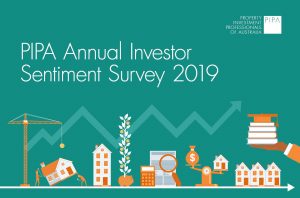Each year, PIPA conducts a survey on the sentiment of property investors and the property market perception for the year ahead.
If you would like to download the report Click Here.
Key points:
- 1200 people surveyed
- Most comprehensive snapshot in Australia
- People more ‘positive’ than same time last year

- Two largest concerns were access to lending and the overall economic conditions
- Labor Party’s Capital gains policy influenced the way that 75% of respondents voted.
- 59% of investors more likely to consider a non-major lender, this can be second tier or non-bank
- 25% found themselves in a position unable to re-finance due to tight lending criteria. (this may have changed)
- Landlords passing on costs of changes to legislation to tenancy laws.
- 1/3 of first time buyers identified as Rentvestors
- 45% of respondents looking outside their own state
- Sydney had 55% increase in appeal for investment, moving from 9% last year to 14% this year for investors.
- 88% of investors believe more education is needed and
- 93% say their advice should come from a source with formal training.
Annual Review
In the middle of each year, the Property Investment Professionals of Australia (PIPA) conducts a survey of property peoples who like responding to surveys. They don’t have to be investors but the majority of questions were related to investors and the findings are always good to review.
We need to remember that while there is no other snapshot of this type in Australia, this document is still primarily circulated throughout the PIPA network and the results may or may not reflect that.
For example, I sent this to our clients and our pages on Facebook. Do the people connected with us represent a cross section of household in Australia or are they specific to our way of viewing things? Do they even represent a cross-section of property investors or are they weighed towards our type of advice and information driven services?
Who knows, but there is nothing else out in the market like this, so it is the best report we have got to review.
They big takeaways this year are that the investor sentiment has had a big shot in the arm from last year with 82% of investors believe that now is a good time to invest in residential property, up from 77% last year.
What does this mean?
Are they all educated as to where to buy?
I think there are good buys around the country and I would think most people are more hopeful about the market but
Hope doesn’t make money…
The data does not show the way respondents voted of course, but it does indicate that most people (75%) took into consideration the Labor Party Capital Gains policy and were influenced to vote accordingly.
The largest concern that the surveyed people had, access to lending and overall Australian economic market conditions.
Both of these concerns are highly valid and accurate in my opinion. On that note, it was found that given the tighter lending criteria up to that point, a whopping 25% of those surveyed found themselves in a position unable to refinance.
25% can’t refinance!
That is a staggering number of people. With the changes in the past few months from July I would think the ability to refinance and obtain finance in general has increased due to APRA assessment rate changes and RBA rate reductions.
Nonetheless, 25% is a large number to have issues with refinancing and this needs to be watched as it is a red flag for some markets.
On the topic of borrowing, 55% said they are more likely to consider using a second tier or a non-bank lender. This means that the big 4 banks are out of flavor with the people behind these answers. That is probably not unusual considering the hammering that the majors coped from the Royal Commission. To be honest, banks are always involved in some sort of scandal or issue with the public in some way. What is surprising is that this time, they have not been as successful in marketing themselves out of the bad press.
This time, more mud has stuck, and for longer.
The conditions therefore favor the emergence of second tier lenders and non-bank participants. Second tier are the likes of Bendigo Bank and non bank can be credit unions and private lending institutions, essentially, anyone who lends but does not have a full banking license.
I won’t delve too much here, but this market environment also has led to the creation of Neobanks, which will cover that in a separate article.
Investing stats
Landlords are looking to pass on the costs of legislative changes and state/federal requirements for tenancies. Wow who would have thought that. The user always pays, and in the case of a rental, the tenant is the user. It comes as zero surprise to me that costs increased to landlords find their way to the tenant.
Sydney had an appeal increase of 55% for investors from last year, with the real stats suggesting that 14% of people surveyed are looking to buy in Sydney as opposed to last years 9%.
Not a huge number, but considering that Sydney is the largest single market, (if you feel like grouping a whole bunch of areas and calling it one market) in Australia, then it makes sense.
Outside your state?
On top of the Sydney comments, 45% of respondents are looking to Invest outside their own state. This is a good thing for those 45% but really, I would like to see that number at 100%. Everybody should be willing to look for the best investment opportunity, no matter where it, based on the results / figures, not on convenience. Then the decision to invest in your own state is based on what is best for you, not on what is easiest for you.
Rentvesting
There was some first time buyers who responded to the survey and out of them, 1/3 are Rentvestors. These are people who have bought their first property and do not live in it. A third is a decent number of this market and while Rentvesting might be a recent and catchy phrase, I am pretty sure when I was a first home buyer it was called, ‘getting into the market’. You would buy a property and rent it out while still living at home or sharing with others. Anyway, I never knew I was a sophisticated Rentvestor all those years ago…
More Education for Buyers
The last two stats I will discuss are about education. PIPA is all about bringing a minimum standard to the property investment and advice industry, and that is why I am personally a full member and why Real Property Advice Pty Ltd, the company behind Xenium, is also a corporate member.
Of the people surveyed, 88% say more education is needed. The way I read this stat is that more education is needed for the people transacting, not the people advising. To be honest this would line up with my view on the market and the whole reason why I created Xenium. I found that each time we were buying for clients or helping them sell, we were educating, so Xenium covers that consistently and comprehensively through Xenium Real Wealth program, each week.
Dodgy Advice
The final figure is 93%. This is the number of respondents who said their advice should come from a source with formal training. This is also why we are part of PIPA with Professional development needed each year to maintain our membership and, along with Xenium Real Wealth, you can be sure you are receiving information from an accredited, educated and informed (sometimes opinionated) source.
If you have any questions about this article or the PIPA report please contact us.
If you would like to download the report Click Here.
Xenium is the most strategic and powerful way to supercharge your property wealth… We work with people using their cash or equity to supercharge profits from active transactions, giving them another income each year, for more information on how Xenium can help you or to join our free education program, Click Here.
 Since 2004 Scott Northcott has been helping people buy the best properties for their needs at prices that simply speak for themselves.
Since 2004 Scott Northcott has been helping people buy the best properties for their needs at prices that simply speak for themselves.
Scott has been instrumental in bridging the gap between financial planning and traditional real estate transactions through his property advice model.
By carefully considering his clients’ goals and planning for market changes via demographics and trends, Scott designs a future proof outcome not only specific to the client’s needs but dynamic in its execution with performance indicators and exit strategies built in.

